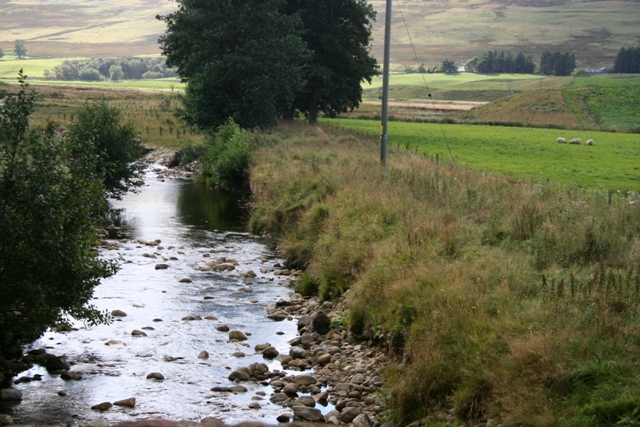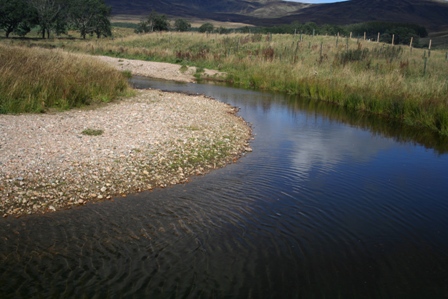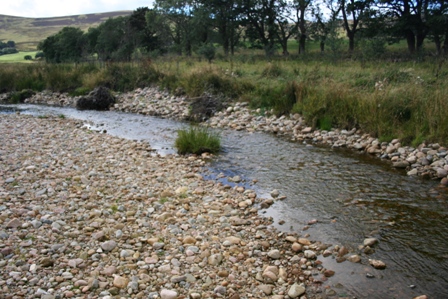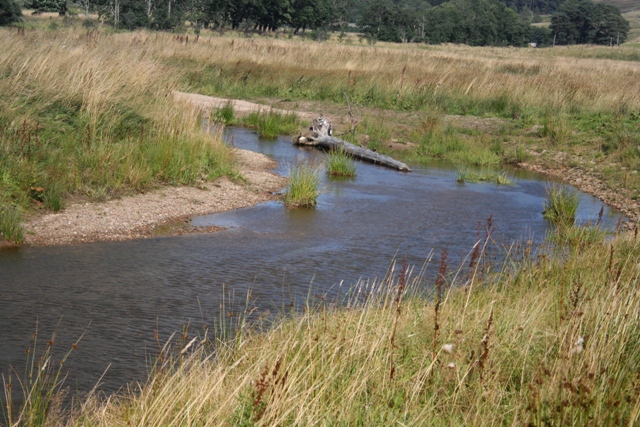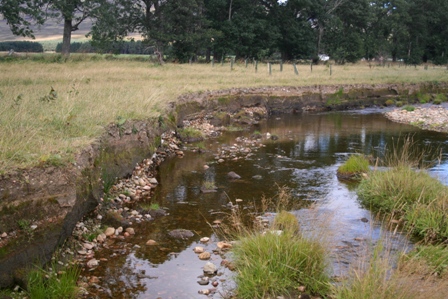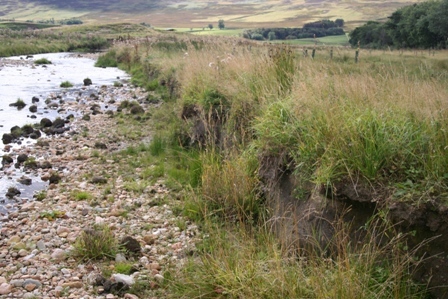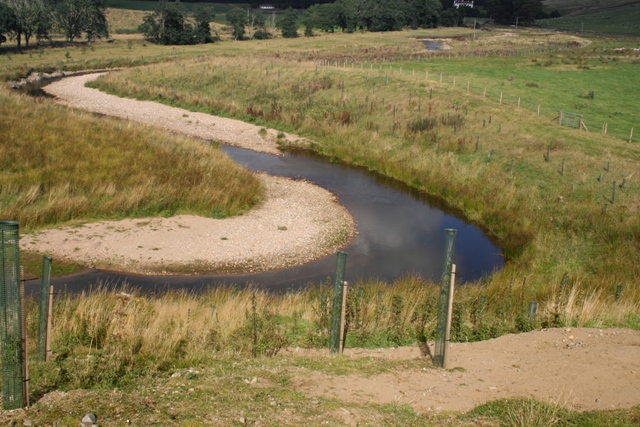These bulletin blogs represent news about Finavon and the South Esk, and my views as a riparian owner. While I may digress at times to write about other places, these are not the views of any other organisation, nor are they designed to promote the interests of any individual or organisation other than Finavon Castle Water and factors affecting the fishery. Tony Andrews
I admire the Rottal Burn restoration Project. With squinted eyes and a bit of imagination, I can surmise what the new course of the burn and its surroundings might look like in 20 years from now. It looks nice, doesn’t it? The burn now has natural features such as a riffle-pool-riffle sequence, bends, deeper pools, gravel bars and erosion zones. It is starting to look natural, which should please the human eye. Furthermore, I have seen both fry and parr in its pools.
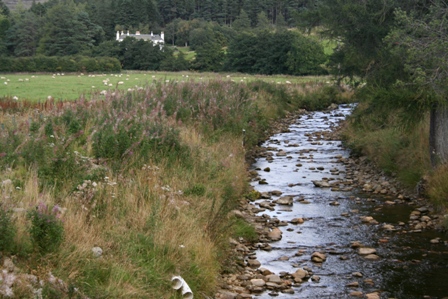
Looking upstream towards Rottal Lodge from the bridge
The view downstream from the bridge to the start of the restored section of the Rottal Burn
The two photos above show what the Rottal Burn looked like before the restoration in 2012. The straight, dredged channel can clearly be seen, but we should not dismiss the benefits of this high energy, well oxygenated channel that contains ideal sizes of spawning cobbles and gravel. The issue here is not the spawning itself, but the lack of cover and varied habitat for juvenile salmon and sea trout at the fry and parr stages of their growth. The photos were both taken from the bridge at Rottal looking upstream towards the Lodge and downstream towards the confluence. These two photos are a good basis from which to compare the other photos in this blog.
It is well worth reading the ERFT report on the management plan 2009-2012. The report lists the benefits of the planned restoration as the creation of diverse riparian and aquatic habitat, a return to a more natural flow regime, attenuation of flood peaks, visual enhancement of the area, restoration of functional, sustainable populations of salmon and sea trout, investigate the transfer of freshwater mussels into the burn, develop a demonstration site for future research.
www.erft.org.uk/images/uploads/EsksFMPupdatereport.pdf
Nevertheless, there is good reason to ask some basic questions about the genesis of this project, not least among which is the question, “Why did we do it, as opposed to a more obvious stock enhancement project based on a credible baseline data set?”
A bend in the newly scoured channel, a naturally depositing gravel bar, and a pool with real depth and bank cover for juvenile salmon and seatrout.
The Rottal Burn restoration was an innovative and costly project, but was this high profile morphological intervention necessary?
Excellent riffle and cobble stratum for spawning and juveniles.
Did the project provide value for a considerable amount of tax payers’ money? If you had £150,000 (or thereabouts) allocated to enhancing South Esk habitat for salmon and sea trout, is the Rottal project how you would spend it?
Woody debris and a deeper channel for juveniles. Just one winter of floods and scouring produced this ideal salmonid habitat.
How will we know if it was successful or otherwise?
Erosion in progress. Good quality spawning stratum for salmon in a stretch of the new channel which is clearly widening with every flood.
In other words, are there success measures in place and, after one year since the project was completed, are its outcomes becoming apparent?
Erosion and riffle. The natural process of erosion, a constant and continuous process since the last ice age in Glen Clova, defines the nature of the ‘itinerant’ and meandering Rottal Burn. All we can do is to start the process and then hand it over to natural morphology.
These questions need to be answered in the context of the priorities for restoration of the South Esk catchment as a whole. It might be said that we should have waited until the results of the Marine Scotland (spring) salmon tracking project were available. A question could be asked about baseline data; for example, were data available on redd counts in the dredged channel of the Rottal burn, and the results of juvenile counts in the burn prior to the project? If there are no such data, how can we know whether the project has improved the recruitment performance of the ‘improved’ section of the burn?
This visually attractive meander had an artificial start, but nonetheless, it is a successful attempt at achieving habitat diversity.
This project should be the start of a debate, not its conclusion. Visually it is fair to say the Rottal Burn project has so far been a success. We need to bear in mind what it looked like before the restoration – a straight dredged channel of one kilometer. Ideally we should now see:
a) reports on salmon and trout spawning and parr recruitment and, if possible, a comparison with what was there before
b) reports on improving fauna and flora diversity, including invertebrates and intoducing the freshwater mussel. Is there better biodiversity than before the project? A step-by-step monitoring of progress would be helpful.
c) comparisons with other tributaries in the upper and middle catchment and the populations they support.
Wildlife observation hut and ‘Field Classroom’ overlooking the restored Rottal Burn
Having got ourselves enthused with the innovation, we now need some cool, objective data to give us a proper evaluation of this project. I look forward to that, but I recognise that it may take time.
TA 23/9
